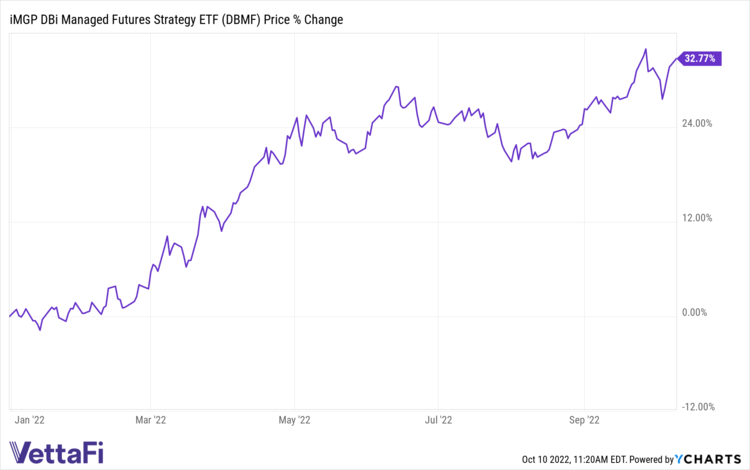Managed futures continue to draw interest and inflows in a year punctuated by market uncertainty and drawdowns. They’ve been one of the few strategies to offer positive performance and returns when the vast majority of over 2,700 ETFs have underperformed this year amidst persistent, soaring inflation and an aggressive Fed monetary policy.
The performance shouldn’t come as a surprise; managed futures have been called the crisis alpha generators since the financial crisis in 2008 for their ability to flourish in times of market dislocations and volatility when more traditional allocations suffer. Yet their continued strong, uncorrelated return stream this year has caused even the dubious trend-following skeptics to take notice.
Managed futures take positions, both long and short, on a range of asset classes through the futures market based on how those assets are trending, not on a prediction of where they are headed. Managed futures invest across currencies, commodities, bonds, and equities. Big bets this year have included being long on crude earlier in the year, and short on a variety of currencies as the dollar continued to strengthen.
At the forefront of the managed futures ETFs lies the iMGP DBi Managed Futures Strategy ETF (DBMF ), a managed futures fund designed to capture performance no matter how equity markets are moving. DBMF is edging progressively closer daily to the $1 billion mark in AUM ($944.4 million as of 7 October 2022), a remarkable feat considering that the fund had just $60 million at the beginning of the year. Year-to-date, the fund currently has a return of 33.20% as of 7 October 2022.
“Managed futures funds are in crash protection mode — as bearishly positioned as any time during the past decade and a half. They’re betting the chaos continues,” Andrew Beer, co-portfolio manager of DBMF and managing member of Dynamic Beta investments, told Financial Times.
How DBMF Outperforms
The fund seeks to replicate the average performance of the 20 largest managed futures hedge funds, known as commodity trading advisors. This eliminates single-manager bias potential while also capturing more alpha through the greatly reduced fees of an ETF — just 0.85% in the case of DBMF, which is lower than the 2% for hedge funds in addition to the 20% performance fee when the hedge funds perform well.
Content continues below advertisement

Image source: Financial Times
“We have outperformed all 20 [underlying CTAs] on a net of fees basis,” Beer said. “We outperform in the smartest and most old-fashioned way: we are cheaper.”
Managed futures as a strategy have gotten a bad reputation over the last decade or more when equities and bonds both performed strongly and diversifier strategies suffered broadly. Now, as the market regime changes — a change that is likely to play out over the next decade — portfolio diversifiers are proving their worth when equities and bonds have both been declined in tandem.
“DBMF’s strong performance has made advisors take a closer look at the role managed futures can play in a portfolio. While the investment style is under the radar, management has done an excellent job with education, raising the fund’s visibility,” explained Todd Rosenbluth, head of research at VettaFi.
The position that the fund takes within domestic managed futures and forward contracts is determined by the Dynamic Beta Engine. This proprietary quantitative model attempts to ascertain how the largest commodity-trading advisor hedge funds make their allocations. It does so by analyzing the trailing 60-day performance of CTA hedge funds and then determining a portfolio of liquid contracts that would mimic the hedge funds’ performance (not the positions).
DBMF takes long positions in derivatives with exposures to asset classes, sectors, or markets that are anticipated to grow in value and takes short positions in derivatives with exposures expected to fall in value. Under normal market conditions, the fund seeks to maintain volatility between 8%–10% annually.

DBMF has a management fee of 0.95%.
For more news, information, and strategy, visit the Managed Futures Channel.

